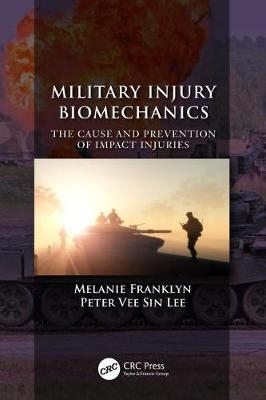
Military Injury Biomechanics
Crc Press Inc (Verlag)
978-1-4987-4282-5 (ISBN)
Military Injury Biomechanics: The Cause and Prevention of Impact Injuries is a reference manual where information and data from a large number of sources, focussing on injuries related to military events, has been critically reviewed and discussed. The book covers the cause and prevention of impact injuries to all the major body regions, while topics such as the historical background of military impact biomechanics, the history and use of anthropomorphic test devices for military applications and the medical management of injuries are also discussed. An international team of experts have been brought together to examine and review the topics. The book is intended for researchers, postgraduate students and others working or studying defence and impact injuries.
Dr. Melanie Franklyn has a PhD in Biomedical Engineering and is an internationally recognised expert in impact injury biomechanics, trauma, orthopaedics and sports injuries. She is currently employed as a research scientist in impact injury biomechanics at the Defence Science & Technology Group (DST Group) Australia (since 2010) and is also an honorary senior research fellow in the Department of Mechanical Engineering at The University of Melbourne (since 2010). Dr. Franklyn established and developed the capability in military injury biomechanics at DST Group, where her research includes military helmet evaluation, Behind Armour Blunt Trauma (BABT), brain injury prediction using finite element models, the development of injury criteria for the spine and pelvis, and injury prediction methodology for underbelly vehicle blast tests. She also conducts injury biomechanics work at The University of Melbourne, including research on tibial stress injuries, trauma and orthopaedics. Dr. Franklyn was previously employed as a research fellow at the Monash University Accident Research Centre (2001–2009 inclusive) where her research focused on occupant injury in automotive crashes, crashworthiness, computer modelling, injury coding, trauma and sports injuries. She is a certified abbreviated injury scale specialist through the Association for the Advancement of Automotive Medicine (AAAM) and is a qualified injury coding instructor. Dr. Franklyn is on the editorial board of the World Journal of Orthopaedics and is a reviewer for various international journals and granting bodies. She has also supervised numerous graduate student projects and her research has been featured in various forums such as the ABC Catalyst TV programme. Dr. Peter Lee is currently a professor in the Melbourne School of Engineering at The University of Melbourne. He obtained his BEng in Mechanical Engineering (1991) and PhD (1996) in bioengineering from the University of Strathclyde, UK, and continued his post-doc in the same university from 1996 to 1998. He was a research fellow with the Biomaterials Group at the Institute of Materials Research and Engineering, Singapore, from 1998 to 2001. In 2001, he joined the Defence Medical and Environmental Research Institute, DSO National Laboratories, Singapore, as the head of the Bioengineering Laboratory. He joined The University of Melbourne as a senior lecturer in 2008. Professor Lee is recognised internationally in tissue biomechanics research, injury biomechanics and rehabilitation engineering. He has published more than 140 articles in journals, conference proceedings and books. He currently leads a research team focusing on understanding impact-type injuries to the body, leading to effective prevention strategies. His research spans all three levels – the human, organs and cells. These investigations also apply computational models to further understand diseases and injuries to the various joints in the body.
Introduction. Injury coding and classification. The physics of ballistic and blast threats in the military environment. Injury Criteria for Military Scenarios. The Skull and Brain: Blast and brain injury. The Skull and Brain: Brain injury from helmet backface deformation. The Skull and Brain: Test methods and helmet design. Skull and facial trauma. The Ear: Models for eardrum rupture. The Neck: Traumatic injury to the neck. The Neck: Neck Injury and Pilot Ejection. The Thorocolumbar Spine: Cadaveric testing. The Thorocolumbar Spine: Injury Criteria for traumatic spinal injury. The Thorax: BABT and chest injury. The Thorax: Theoretical Models for blast lung injury. The Thorax: Computer modelling of blast lung injury. The Abdomen: Abdominal injury from armour backface deformation. The lower extremities: Cadaveric impacts to simulate lower limb injuries in mine blasts. The lower extremities: Crash test dummy legs and injury criteria. The lower extremities: Computer models of the lower limbs for military scenarios
| Erscheinungsdatum | 04.07.2017 |
|---|---|
| Zusatzinfo | 60 Tables, black and white; 170 Illustrations, color; 99 Illustrations, black and white |
| Verlagsort | Bosa Roca |
| Sprache | englisch |
| Maße | 178 x 254 mm |
| Gewicht | 1065 g |
| Themenwelt | Medizin / Pharmazie ► Physiotherapie / Ergotherapie ► Orthopädie |
| Technik ► Medizintechnik | |
| Technik ► Umwelttechnik / Biotechnologie | |
| ISBN-10 | 1-4987-4282-3 / 1498742823 |
| ISBN-13 | 978-1-4987-4282-5 / 9781498742825 |
| Zustand | Neuware |
| Haben Sie eine Frage zum Produkt? |
aus dem Bereich


